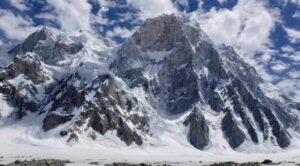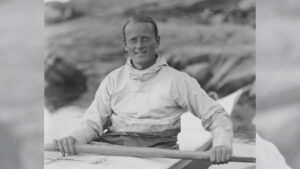The almanacs of climbing history prefer not to include it. The lists of ascents prefer not to list it. This is the story of Cho Oyu in 1964 and the Stammberger case.
Cho Oyu and its third ascent
Cho Oyu is 8,201m high and is the sixth highest mountain on Earth. The “Turquoise Goddess” of the Himalaya is 20km west of Everest, on the border between China and Nepal. An Austrian expedition first climbed it in 1954.
On April 4, 1964, an expedition from West Germany arrived at Cho Oyu Base Camp. The team included Sepp Gschwendtner, Georg Huber, Friedrich Ludwig (Fritz) Stammberger, Dr. Alois Thurmayr, Dawa Tenzing Sherpa, Phu Dorje II, Aila and Lhakpa Norbu Sherpas. Rudi Rott was the leader.

The normal route on Cho Oyu Photo: Seven Summit Treks
After acclimatizing, they established Camp 1 at 6,300m on April 16. After three days of rest, they continued to Camp 2 at 6,450m. Two of the Sherpas turned around, one because of pneumonia, and the other because of altitude sickness. Rott didn’t climb.
On April 22, the team reached Camp 3 through a vertical section of dangerous ice. The German climbers carried their skis and their backpacks with the intention of skiing from the top. Thurmayr panicked upon seeing the ice wall, and Phu Dorje became very nervous as well.
The next day, they reached 7,200m, where they established their Camp 4 and rested.
The summit push
On April 25 at 9 am, they began their summit push. Thurmayr and Huber climbed very slowly, Stammberger and Phu Dorje II were ahead. All four were in their twenties. None of them used bottled O2.
Stammberger and Phu Dorje II made it to 50m below the main summit. Phu Dorje stayed there, but Stammberger decided to climb to the main summit. He was going to ski down from the top. Eventually, he left his skis behind but still climbed in his ski boots. At 5 pm, he topped out.

Fritz Stammberger was 1.90m tall, with excellent skiing and climbing skills. Photo: Mike Marolt
Descending to 7,500m, he found Huber and Thurmayr, who were going to bivouac so that they could summit the next day. Night fell and the temperature plummeted, so they decided to go together to Camp 4. It was then that Thurmayr started showing clear symptoms of altitude sickness.
On April 26, they all spent the day sleeping in Camp 4. Thurmayr’s condition began to deteriorate and Huber started to feel ill too. The group had already been on the mountain for 12 days. To make matters worse, their fuel ran out and they couldn’t melt snow for drinking water.

Camp 3 and the view up toward the Yellow Band. Photo: Phunuru Sherpa
No gas, no water, and altitude sickness
On April 27, any hope the rest of the group had of summiting had vanished. Phu Dorje started to descend to Base Camp to get more gas and some food. On April 28, the rest wanted to go down but the situation became complicated. Thurmayr could not stand up, and the altitude sickness made him violent.
Stammberger put on his skis, and at 11 am, he started to ski down for help. He was exhausted and dehydrated. Despite this, he descended from 7,200m to 6,400m in just 25 minutes. Between Camp 1 and Camp 2, he found some liquid and drank it, but it later turned out to be toxic, containing gasoline.
He arrived at Base Camp at midnight, but the next day he felt sick and was ill for the next three days.
Too late
Team members in Base Camp had trouble getting to Camp 4. It wasn’t until May 6 that Stammberger, Dawa Tenzing, and Phu Dorje finally made it up. Unfortunately, Huber had already been dead for two days and Thurmayr perished during the rescue.

Cho Oyu at sunset seen from Chinese Base Camp (4,908m). Photo: Mountains of Travel
An impressive, light ascent of Cho Oyu, and what was then the highest ski descent in the world, was overshadowed by the failed rescue. Controversy surrounded the expedition, and specifically Fritz Stammberger. Some held him responsible for the deaths of his two companions. They blamed him for not acting assertively at Camp 4, with two sick climbers who insisted on trying to reach the top.

The South Face of Cho Oyu at sunrise from Gokyo. Photo: Mountains of Travel
Some people did not accept his summit either, citing a lack of reliable evidence. They criticized his summit photos that appear to show that the ski pole (that served as a flagpole at the top) was apparently on the western slope of the mountain and that in the image the sun was still very high, suggesting that he had taken it around 2 or 2:30 pm rather than his claimed 5 pm.
A success?
The Himalayan Database rated the ascent as “Success (Claimed)”. However, the American Alpine Club published an article about the successful ascent in 1965. Later, Phu Dorje Sherpa claimed that he had also climbed with Stammberger to the top.
The Himalayan Database includes the opinion of Reinhold Messner, who in 1986 said that Fritz Stammberger did not climb Cho Oyu in 1964. Messner voiced his opinion again in his book Cho Oyu – Gottin des Turkis.
But why wouldn’t he climb the last 50 metres to the top? The climb remains unresolved in mountaineering circles.
Mountaineering historians have largely ignored Stammberger’s climb. The first high-altitude ski descent (or attempted descent) on an 8,000’er is usually listed as the 1980 Everest ski by Japanese climber Yuichiro Miura. Regarding Cho Oyu, most sources point to Veronique Perillat in 1988 on a single ski, from the top to Camp 1. Stammberger barely ever gets mentioned, despite his ski descent from 7,200m to Base Camp.
After Cho Oyu
As a skier and climber, Fritz Stammberger was well ahead of his time. Born in 1940 in Germany, he witnessed as a child the bombing of his home and the death of his mother.
In 1963, he emigrated to Aspen, Colorado, but kept his West German citizenship. He founded a printing press and worked as a ski instructor.

The Deadly Bells are two peaks in Colorado’s Elk Mountains. One is Maroon Peak (4,317m) and the other is North Maroon Peak (4,273m). Stammberger was the first to ski down them.
After Cho Oyu, he continued to climb and ski. In the second half of the 1960s, he made numerous ascents and ski descents on the most demanding mountains in the U.S. He was an environmentalist, he opposed tobacco advertising, and his passions included reading and solo climbing.

South Face of Makalu, unclimbed in 1974. Photo: Jeff Long
In autumn 1974, he led a mixed-nationality team to climb the South Face of Makalu. At 7,800m, bad weather forced them to turn around.
Tirich Mir
In 1975, he attempted the Pakistani peak Tirich Mir (7,690m) for the third time. Stammberger went alone. He had two previous attempts on this mountain: one in 1962, also solo, when at 6,100m he was swept down by an avalanche and was lucky to survive. Then another failed attempt in 1974.
On this third attempt, he disappeared completely.

At the time, Tirich Mir was a dangerous place. Stammberger’s friends believe that he successfully climbed it. Photo: Caingram Info
After his disappearance, it was rumored that he was a spy, helping to establish secret stations on the mountain.
Two friends went to look for him, but they only found a backpack containing a map, a couple of books, and rather strangely, an electric heating pad. They went up as high as they could in a helicopter and spotted some footprints but nothing else.
A double life
His wife Janice Pennington, a model on the American television game show The Price Is Right, continued to investigate his death until 1992. She spoke to members of the U.S. and Soviet secret service on multiple occasions, even traveling to meet them.
She eventually discovered that the CIA had recruited Stammberger in 1974. His task was to collect information and help organize bases in Afghanistan and Pakistan.
Pennington obtained a classified report that revealed that Stammberger was involved with the mujahideen who were fighting against the Soviet Union and that he died in the early 1980s on Afghan soil, not far from Tirich Mir. She published her findings in the book Husband, Lover, Spy.

Stammberger. Photo: Rock and Ice
Some of Stammberger’s friends, including Michael Ohnmacht, think that Stammberger had an accident on Tirich Mir and was not a spy. Others speculate that the region was very dangerous at the time and that he could have been murdered. Pennington later discovered that Stammberger did not have a permit for Tirich Mir in 1975.
The mystery remains unresolved.






